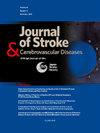Differences in subacute motor recovery after intracerebral haemorrhage and ischaemic stroke: Analysis using the VISTA database cohort
IF 2
4区 医学
Q3 NEUROSCIENCES
Journal of Stroke & Cerebrovascular Diseases
Pub Date : 2025-03-05
DOI:10.1016/j.jstrokecerebrovasdis.2025.108266
引用次数: 0
Abstract
Background
Motor impairment is a significant contributor to disability after stroke, but recovery is often incomplete. Whether motor recovery differs between intracerebral haemorrhage (ICH), a subgroup of stroke with far worse outcomes, and ischaemic stroke is not clear.
Methods
We performed a retrospective observational longitudinal cohort study using individual patient-level data from the Virtual International Stroke Trials Archive (VISTA) database (ICH n=892, ischaemic stroke n=6912). Differences in motor recovery to 90-days were examined between ICH and ischaemic stroke patients with mixed effect regression models adjusted for a priori determined confounders. Motor weakness was measured by NIHSS face, arm and leg sum with secondary analyses of total NIHSS, and NIHSS language score.
Results
Recovery was observed in all NIHSS domains for both stroke types to 30-days (NIHSSmotor b=-2.78, 95%CI -2.89,-2.68; NIHSStotal b=-5.74, 95%CI -5.92,-5.56; NIHSSlanguage b=-0.28 95%CI -0.31,-0.24) and 90-days (NIHSSmotor b=-3.62, 95%CI -3.69,-3.54; NIHSStotal b=-7.17, 95%CI -7.30,-7.05; NIHSSlanguage b=-0.74, 95%CI -0.78,-0.71). Baseline impairment between groups was well matched with only motor impairment being slightly greater in ICH; NIHSSmotor mean(SD)=13.0 (5.3) vs 12.3 (5.4). To 30-days the extent of recovery was not different between stroke types but recovery to 90-days was greater in ICH for motor and statistically significant for total NIHSS score (b=-0.35, 95%CI -0.71,-0.002). Ischaemic stroke survivors recovered more in NIHSS language domain.
Conclusions
Timing and extent of recovery is different between stroke types. Motor recovery in ICH is greater and occurs later. Therefore, the assumption that most recovery occurs within 30-days and proportionality of recovery should be revisited in this population.
脑出血和缺血性脑卒中后亚急性运动恢复的差异:使用VISTA数据库队列分析
运动障碍是中风后致残的重要因素,但恢复往往是不完整的。脑内出血(ICH)是一种预后较差的卒中亚组,运动恢复与缺血性卒中之间是否存在差异尚不清楚。方法采用来自虚拟国际卒中试验档案(VISTA)数据库的个体患者水平数据(ICH n=892,缺血性卒中n=6912)进行回顾性观察性纵向队列研究。采用混合效应回归模型对先验确定的混杂因素进行校正,研究脑出血和缺血性脑卒中患者90天运动恢复的差异。采用NIHSS面部、手臂和腿部总分测量运动无力,并对NIHSS总分和NIHSS语言评分进行二次分析。结果两种脑卒中类型的所有NIHSS域均恢复至30天(NIHSSmotor b=-2.78, 95%CI -2.89,-2.68;NIHSStotal b=-5.74, 95%CI -5.92,-5.56;nihsslanguor b=-0.28 95%CI -0.31,-0.24)和90天(NIHSSmotor b=-3.62, 95%CI -3.69,-3.54;NIHSStotal b=-7.17, 95%CI -7.30,-7.05;nihslanguage b=-0.74, 95%CI -0.78,-0.71)。各组间基线损伤匹配良好,脑出血组仅运动损伤略大;NIHSSmotor均值(SD)=13.0 (5.3) vs 12.3(5.4)。到30天,脑卒中类型之间的恢复程度没有差异,但到90天,运动脑卒中患者的恢复程度更高,NIHSS总评分也有统计学意义(b=-0.35, 95%CI -0.71,-0.002)。缺血性脑卒中幸存者在NIHSS语言域恢复较多。结论不同脑卒中类型患者的恢复时间和恢复程度不同。脑出血患者的运动恢复更大,发生更晚。因此,大多数患者在30天内恢复的假设和恢复的比例应该在这一人群中重新考虑。
本文章由计算机程序翻译,如有差异,请以英文原文为准。
求助全文
约1分钟内获得全文
求助全文
来源期刊

Journal of Stroke & Cerebrovascular Diseases
Medicine-Surgery
CiteScore
5.00
自引率
4.00%
发文量
583
审稿时长
62 days
期刊介绍:
The Journal of Stroke & Cerebrovascular Diseases publishes original papers on basic and clinical science related to the fields of stroke and cerebrovascular diseases. The Journal also features review articles, controversies, methods and technical notes, selected case reports and other original articles of special nature. Its editorial mission is to focus on prevention and repair of cerebrovascular disease. Clinical papers emphasize medical and surgical aspects of stroke, clinical trials and design, epidemiology, stroke care delivery systems and outcomes, imaging sciences and rehabilitation of stroke. The Journal will be of special interest to specialists involved in caring for patients with cerebrovascular disease, including neurologists, neurosurgeons and cardiologists.
 求助内容:
求助内容: 应助结果提醒方式:
应助结果提醒方式:


